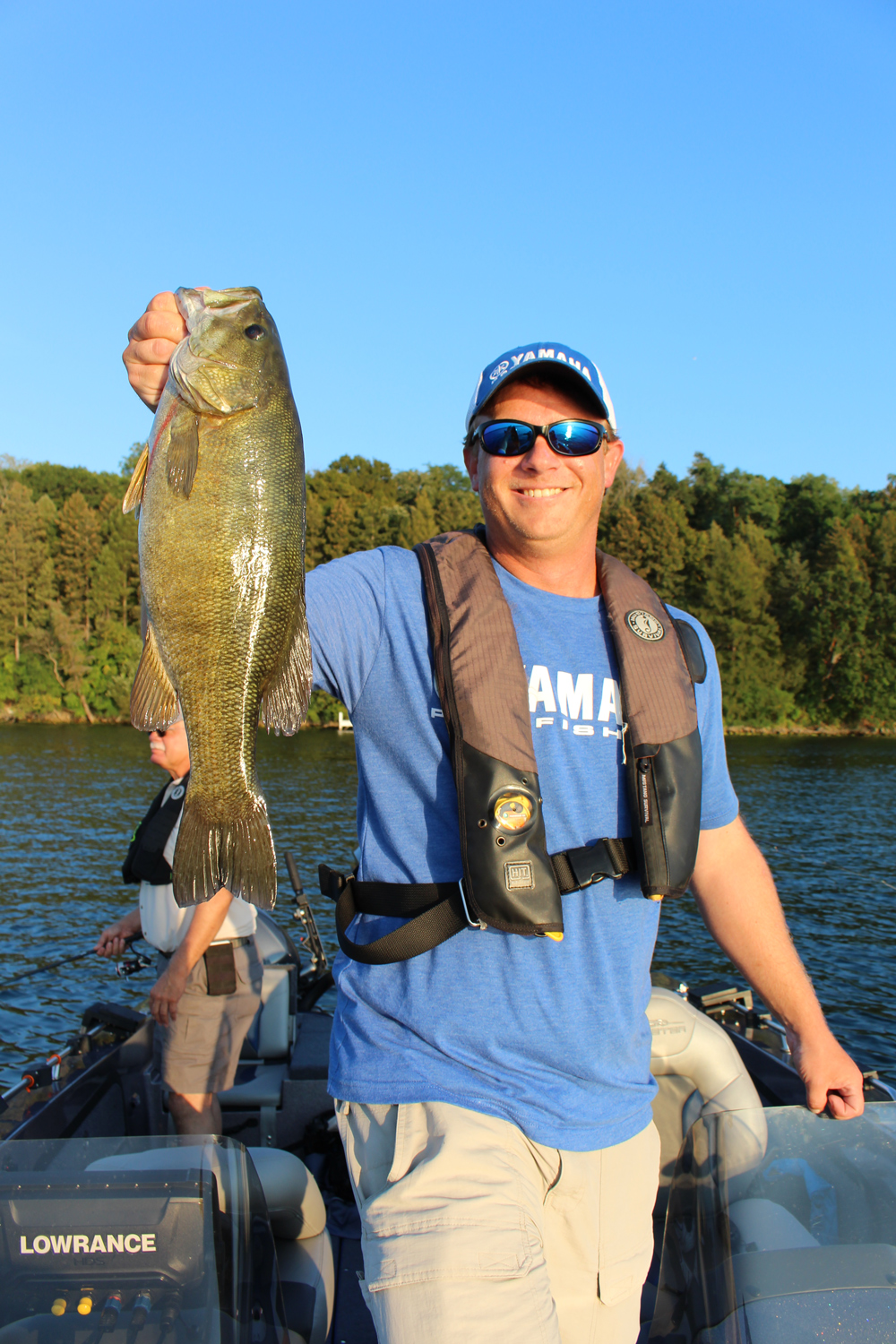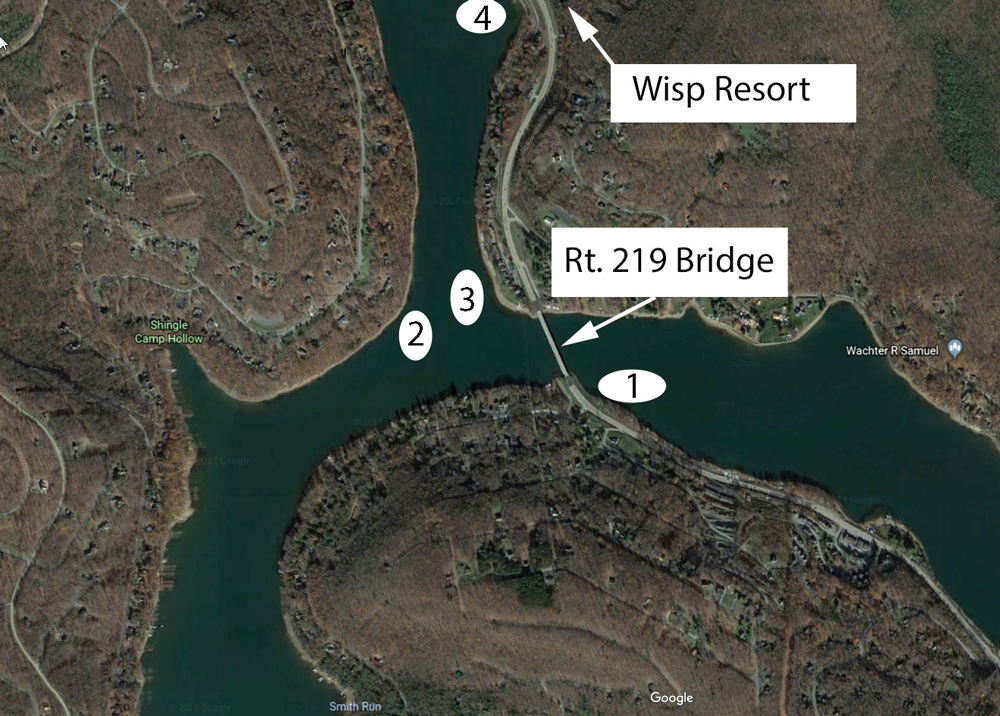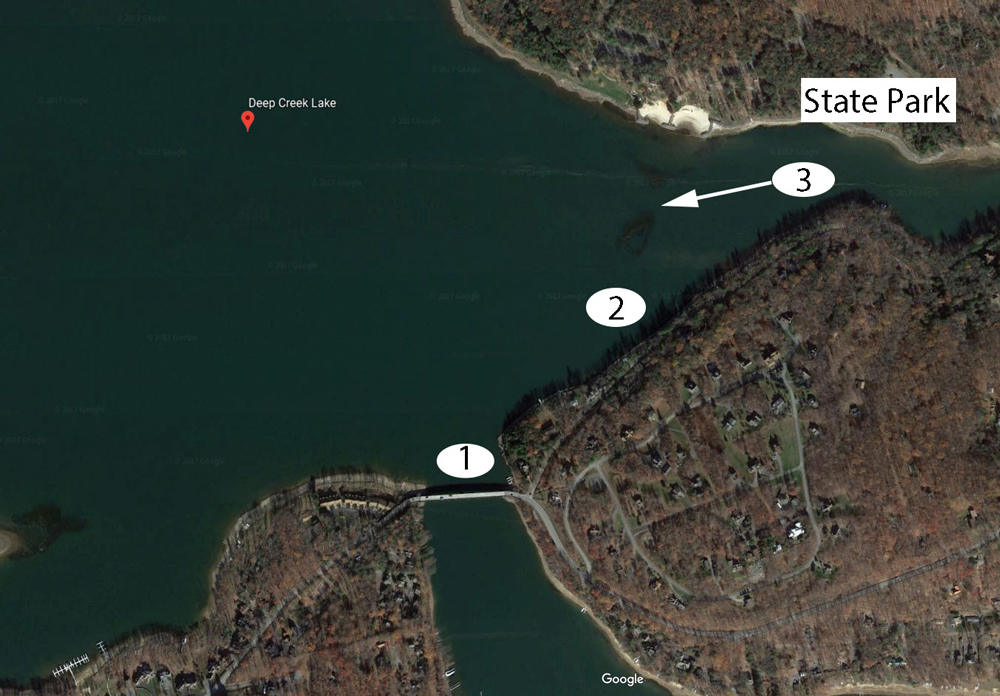Deep Creek Lake, located in western Maryland, is a vacation spot and fishing destination for people all year round. But if you’re rather try some KISS bass fishing while the rest of the family hits the links, try ice fishing when everyone else hits the ski slopes, or troll for walleye when everyone else wants to go water skiing, the two zones of the lake we’ll detail here will be of interest.

First, some basic facts about fishing in Deep Creek. This is a massive lake, with close to 70 miles of shoreline and 4,000 water-acres. You could write a book detailing every cove and creek, which is why in this article we’ll focus on two specific but large areas which are easily accessed. The lake hits depths of 75 feet, has a number of access points for both shoreline and boat anglers, and the list of species swimming in these waters is quite long: largemouth bass, smallmouth bass, walleye, northern pike (including the current state record of 24 pounds, 12 ounces), yellow perch, pickerel, crappie, sunfish (including the three pound, seven ounce state record bluegill), and several types of trout.
Bass anglers hitting the lake should be less concerned about the spots we’re focusing in on here, and more interested in two specific patterns for this species. As a rule of thumb, the best bass angling takes place during the warmer months of the year along the shoreline. Docks are the main form of structure, and there are plenty of them –at least, from April through the end of November. During the winter months, docks must be removed from the lake. The second thing bassers need to be aware of is that during the summer months, especially during weekends, the lake is thoroughly congested and busy. Gobs of boat traffic and people enjoying watersports mean that the best bass fishing is almost always right at daybreak and right at sunset, when the lake is the calmest.
For most of the other species found here, the key structures to look for include sharp drop-offs (walleye, yellow perch, and sometimes crappie), weed beds (pickerel, pike, bluegill, and sometimes crappie) and submerged structure like timber (all of the above, at different times of the year).
Rt. 219 Bridge and Surrounding Areas
Just down the rod from Wisp ski resort, the Rt 219 bridge is one of the most recognizable landmarks on the lake. That means there’s a lot of business focused in the immediate area, and boats can be rented at several locations close by in Marsh Run Cove. From the public ramp at the state park it’s about a two-mile run. There’s also public access for shoreline angling at the southern base of the bridge. This means walking on rip-rap, which isn’t always the most comfortable, but plenty of fish like feeding around that rip-rap, too. Which leads up to our Rt 219 area map, and…

Hotspot #1 – This stretch of rip-rap congregates walleye, yellow perch, and occasionally anglers here will luck into a pike, as well. A good cast will get your offering just beyond the rocks, which is not only a good zone to place a bait, but also results in fewer snags that one might imagine. A great way to fish here is to rig a #2 to #4 hook directly on the end of eight to 12 pound mono, add a split-shot two feet above, and lip-hook a live medium or large shiner. Then cast it out and sit the rod down with the reel in freespool or the bail open, and watch for your line to race off when a fish bites. The important thing when using weighted baits like this here is to reel in quickly and with your tip up, to stay out of the rocks, when you bring in a line.
Hotspot #2 – This area has a very large, sharp drop-off from 20 feet down into water hitting the upper 50’s. There’s some standing timber and rocks on the bottom, both of which help attract fish. If you can locate some of the standing timber with your fishfinder (it’s on the sparse side and can be difficult to locate sometimes) you’ll also encounter crappie and sometimes extremely big bluegill. This is an excellent area for boat anglers to probe deep for walleye and perch, and it’s also a very productive area for these same species when the lake freezes over and you can fish through the ice.
Hotspot #3 – This is essentially a continuation of the deep water found at Hotspot #2, but it’s a narrower zone and is bordered by sharp drops on either side. The water doesn’t get quite as deep here, maxing-out in the upper 40’s, but the edges of the drop-offs are rocky and sharp and walleye love hunting along their bases. In the shallower flats outside of the channel, you’ll sometimes encounter pike.
Hotspot #4 – This small notch in the shoreline of Marsh Run Cove has surprisingly deep water (in the mid 20’s) in the middle, and a gradual drop-off along the southern edges. There’s also a mix of deeper water and relatively shallow flats in the middle of the main cove, just outside this off-shoot. At the outer edge of the mark on this illustration, there are some humps that rise to 10 feet yet are just a stone’s throw from 40-foot-plus depths. This means there are a lot of options, all contained in and around this one small hotspot. Depending on the time of year, on the flats you may locate weed-beds holding bluegill, pickerel, or pike, with yellow perch along the deeper edges. Note that the close proximity to civilization and boat rentals means that this can be a difficult area to fish during the middle of the day in the summer months.
State Park Area
The State Park area map details three other hotspots, but before we get to them we should note that the state park itself offers gobs of shoreline that’s all public access. There are also a few pull-offs along the road leading up to it (near Hotspot #3 on the south side of the cove) which ice anglers can use to access the lake, but look for the “no trespassing signs” and stay away from those areas, to keep everyone happy. Boat anglers can launch at the (large and rather excellent) public facility in the park, which will put you less than a mile from all these spots.

Hotspot #1 – This is the Glendale bridge, which had sheer drop-offs on either side and gets down below 40 feet in the middle. At many times of year this is a good area to look for crappie, hovering mid-depth around the bridge pilings. Jigging with a two-inch soft plastic tube jig (red/white, white, and lime-green/white combinations work well) on a 1/8th to 1/16th of an ounce jig head, tied to the end of a four-pound-test ultralight rod, is a great way to get them biting. In the deeper sections you’ll also encounter yellow perch at times and the area certainly has the potential to hold walleye.
Hotspot #2 – The entire long, flat section of shoreline here drops very abruptly to about 20 feet, then more slowly down to 30 and in some areas, 40 feet of water. Both walleye and yellow perch are often found along the transition area, from 20 to 40 feet. We’ve also encountered roving schools of crappie along this drop, in the warmer months of the year.
Hotspot #3 – The drop-off along this shoreline has some standing timber and submerged trees in the 10 to 20 foot range, which attract crappie, yellow perch, bluegill, and also a good number of bass at all times of the year. They can be difficult to fish at times and you should expect lots of snags, so bring extra gear. Just west of this spot, as indicated by the arrow, there’s also a shallow plateau of about 10 feet which is surrounded on three sides by 20-foot-plus water. Weedbeds form here and often provide steady action on big sunfish.
The seven hotspots we’ve detailed on these two illustrations obviously just scratch the surface of the opportunities to be found at Deep Creek Lake. And you can enjoy them at virtually any time of the year, whether you’re fishing from a boat, from shore, or through the ice. So if the rest of the family doesn’t get into angling, drop them off for a round of golf, a day on the slopes, or an afternoon of water skiing, and then head out onto the lake to do your thing. You can meet back up with them later, for a fresh fish dinner.
Sign up here to get the weekly FishTalk Chesapeake Bay and Mid-Atlantic fishing reports in your email inbox, every Friday by noon.